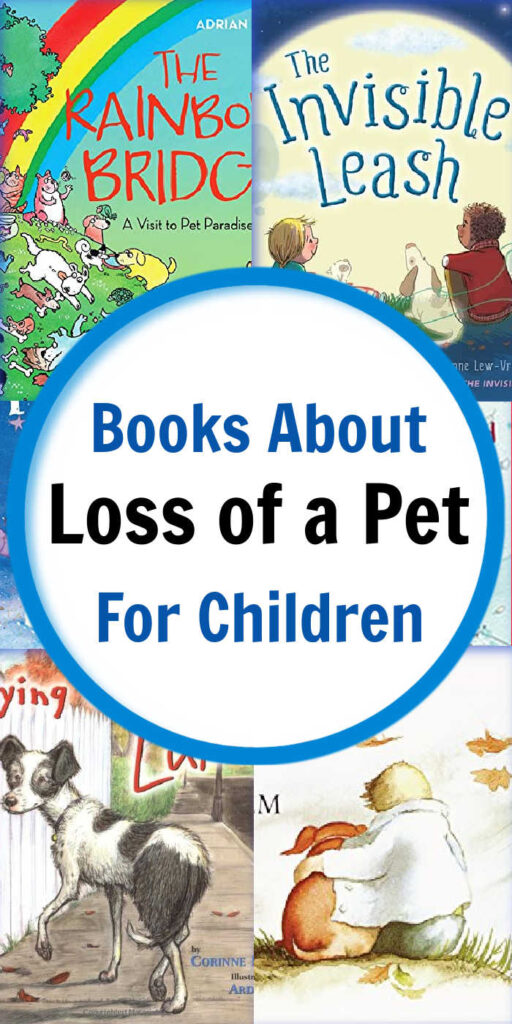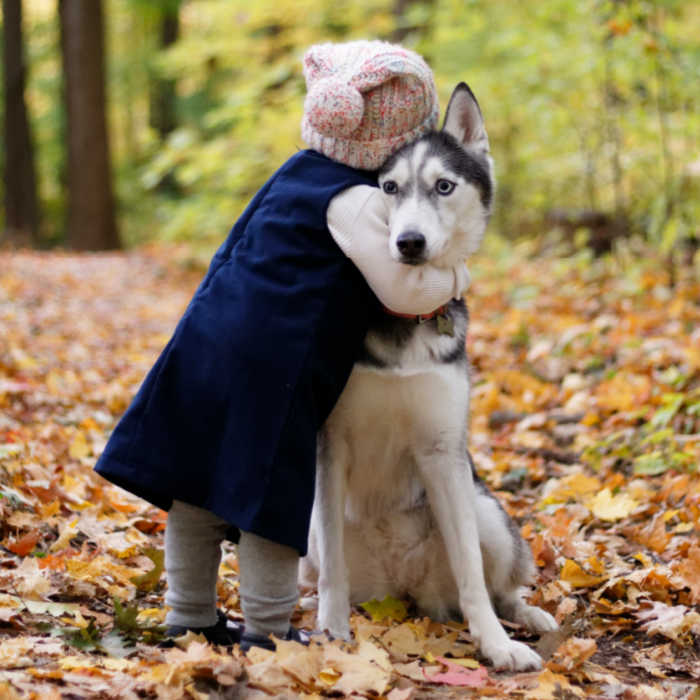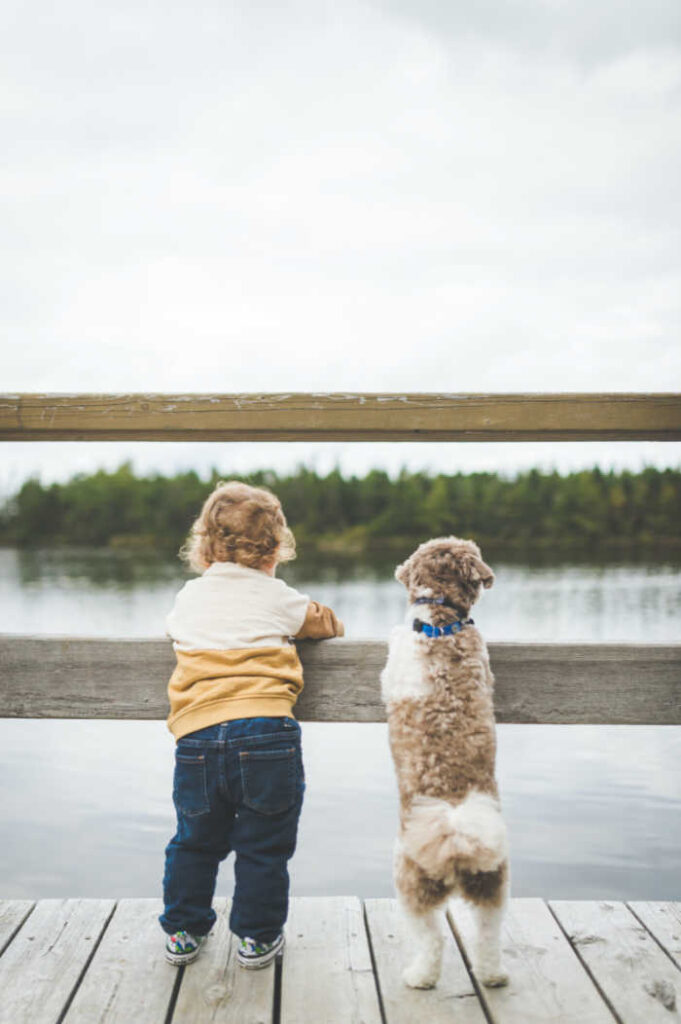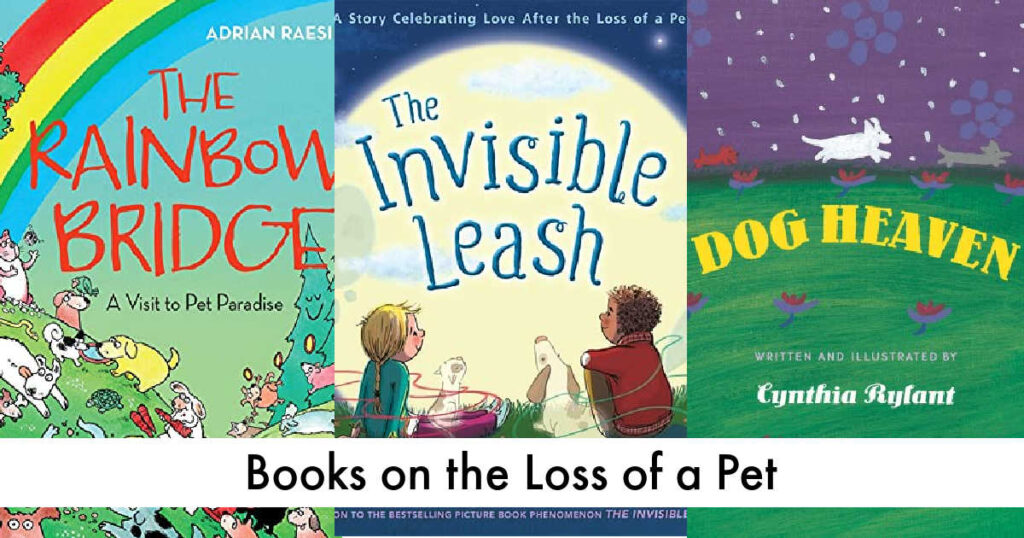Children’s Books on the Loss of a Pet
Reading children’s books about the loss of a pet can help children understand their emotions and come to terms with their grief.
The loss of a pet can be a heartbreaking experience for children, and parents are often at a loss for words in how to explain death to their children. Read together to help begin and support the healing process.
For more reading ideas, visit our extensive list of childrens books for kids!
You can find these children’s books about the loss of a pet at your local library or through the links provided for your convenience.
This post contains affiliate links.

This post contains affiliate links.
Pets are often seen as members of the family, and their absence can leave a void in a child’s life.
Coping with the loss of a pet can be challenging, and finding the right words to explain death and grief can be difficult for parents and caregivers.
Children’s books about the loss of a pet can help children navigate the difficult emotions that come with saying goodbye to a furry friend.
Custom Dog Breed Memorial Suncatcher Custom Dog Photo Ornament – Dog Memorial Gift
Custom Dog Photo Ornament – Dog Memorial Gift Pet Watercolor Memorial Ornament
Pet Watercolor Memorial Ornament Personalized Loss of Pet Sympathy Gift
Personalized Loss of Pet Sympathy Gift
Also, read the Best Childrens Books about Death and Grief to help children understand beyond their pets.
Related Article: When my son’s beloved Beta fish died, here’s how we helped him handle his grief.
And if you have older children, read these Middle Grade Books About Grief and Death.
Why Losing a Pet Hurts So Much
Losing a pet can be an emotionally intense and deeply painful experience. This profound grief is rooted in the strong and unique bonds that people form with their animal companions.
Pets offer unconditional love, unwavering loyalty, and constant companionship. They become cherished family members, and their presence brings immense joy and comfort. Over time, these bonds grow stronger, akin to the connections people share with their human loved ones.
The emotional connection to a pet is profound. They offer a listening ear, a wagging tail, or a soothing purr, providing solace during times of happiness and comfort during moments of sadness. Their non-judgmental nature allows people to be their authentic selves, making the loss feel like a deeply personal tragedy.
Light Up Pet Memorial Plaque Watercolor Pet Portrait From Photo
Watercolor Pet Portrait From Photo Pet Watercolor Pet Portrait
Pet Watercolor Pet Portrait Watercolor Pet Portrait Painting
Watercolor Pet Portrait Painting
Pets also become an integral part of daily routines and lives. Their presence establishes a sense of structure and purpose, offering stability, reducing stress, and alleviating feelings of loneliness. When they pass, this routine is disrupted, and the emptiness left in their absence can be overwhelming.

The pain of losing a pet is magnified by the fact that, in many cases, others may not fully understand the depth of the owner’s grief. This lack of understanding can make the grieving process feel isolating, intensifying the sense of loss.
Loss of Pet for Child
The loss of a pet can be a deeply emotional and sometimes confusing experience for a child.
Here are some considerations and strategies to help children cope with the loss of a beloved animal companion:
Honesty and Open Communication: Be honest with your child about the pet’s passing. Use age-appropriate language and provide simple, clear explanations. Encourage questions and open dialogue to address their concerns.
Emotional Expression: Allow your child to express their feelings. They may feel sadness, anger, confusion, or guilt. Let them know that it’s okay to grieve and that their emotions are valid.
Memorialize and Remember: Create a memorial or remembrance activity to celebrate the pet’s life. This might include making a scrapbook, planting a tree, or writing a letter to the pet. It helps children process their grief and create positive memories.
Share Stories: Share stories and happy memories of the pet. Encourage your child to talk about their favorite moments with their furry friend.
Reassurance: Reassure your child that the pet is no longer in pain or suffering. Explain the concept of a pet’s “rest” or “peace.”
Royal Custom Pet Portrait Handmade Custom Name Cat Decor
Handmade Custom Name Cat Decor Custom Pet 3D Pillow
Custom Pet 3D Pillow Personalized Pet Portrait
Personalized Pet Portrait
Routine and Stability: Maintain a stable routine, especially if the pet’s care was a significant part of your child’s daily life. It provides a sense of security during a time of change.
Books and Resources: Consider reading books about pet loss or using resources specifically designed to help children understand and cope with grief.
Support and Comfort: Be a source of comfort for your child. Offer hugs, cuddles and reassurance as needed. Let them know you are there for them.
Allow Participation: If your child is comfortable with it, involve them in the decision-making process regarding the pet’s burial or cremation, or in choosing a memorial, if applicable.
Time and Patience: Understand that grieving is a process that takes time. Be patient and understanding of the fact that grief doesn’t have a set timeline. Children may revisit their feelings of loss at different stages of their development.
Consider a New Pet: When the family is ready, and if desired, consider getting a new pet. Introducing a new animal can help fill the void, but it’s important to make sure your child is ready and willing to welcome a new pet into their life.
Custom Pet Pillow Dog Drawing From Photo Custom Pet Blanket Using Pet Photo + Name
Custom Pet Blanket Using Pet Photo + Name Custom Comfort Colors Dog TShirt
Custom Comfort Colors Dog TShirt Custom Pet Pillow
Custom Pet Pillow
Remember that every child’s response to pet loss is unique, and the grieving process can vary widely in intensity and duration.

Providing love, understanding, and a safe space for your child to express their emotions is crucial in helping them navigate this difficult experience.
SEL for Kids Starts At Home
As a parent, teaching Social Emotional Learning (SEL) to young children is crucial for their overall development. It helps your child understand and manage their emotions, fostering mental well-being.
SEL cultivates empathy, which is the foundation for healthy relationships and effective communication. These skills are essential for both academic success and life beyond the classroom.
Rather than formally teaching social and emotional skills, these should be integrated into the day to day interactions and activities for your kids.
All Learning Is Social and Emotional: Helping Students Develop Essential Skills for the Classroom and BeyondTeaching with a Social, Emotional, and Cultural Lens: A Framework for Educators and Teacher EducatorsThe SEL Toolbox: Social-Emotional Learning Activities to Teach Kids to Generalize Learned Skills to Real-Life SituationsThe Social-Emotional Learning Toolbox: Practical Strategies to Support All Students
By teaching SEL at home, you as a parent can empower your children to navigate the complexities of human interactions, making them more resilient and socially competent individuals.

Children's Books about the Loss of a Pet
"When our pets aren't with us anymore, an Invisible Leash connects our hearts to each other. Forever."
That's what Zack's friend Emily tells him after his dog dies. Zack doesn't believe it. He only believes in what he can see.
But on an enlightening journey through their neighborhood — and through his grief—he comes to feel the comforting tug of the Invisible Leash. And it feels like love.
Adrian Raeside captures the special bond between humans and their pets, and with marvelous illustrations, brings a gentle humor to a story that will resonate with children and pet lovers of all ages.
Adrian Raeside has created a magical tale of adventure for pet lovers of all ages in The Rainbow Bridge. Using his gift for creating spunky characters, Raeside has created a valuable fable for anyone who cherishes the companionship of a family pet.
Elfie the dachshund is the best dog anyone could every ask for. Every day, she and her owner explore and play together. And every night, her owner tells her "I'll always love you."
Elfie and her owner grow up togther, but growing up can mean having to say goodbye to the ones you love. This tender story is a perfect way to make the topic of loss a little less scary for kids (and grownups).
In Newbery Medalist Cynthia Rylant's classic bestseller, the author comforts readers young and old who have lost a dog, as she did for cats in the bestselling companion book, CAT HEAVEN. Recommended highly by pet lovers around the world, DOG HEAVEN not only comforts but also brings a tear to anyone who is devoted to a pet.
A young girl and her lovable dog, Lulu, are the best of friends and do everything together. As Lulu ages and starts to slow down the girl shows her compassion by making Lulu comfortable in her bed and helping to feed her.
When Lulu dies the caring, young girl must comes to terms with her loss and find a way to say goodbye.
In this useful book from the First Experience series, the affable star of Mister Rogers' Neighborhood helps children share feelings of the loss of a pet while offering reassurance that grieving is a natural, healing thing to do.
The loss of a pet is heartbreaking. But in the heaven of animals, the love you have for your animal friends lives on.
National-bestselling author Nancy Tillman's message of comfort will help readers of all ages through the process of grieving and healing.
With a gentle, playful rhyme, Newbery Medalist Cynthia Rylant explores all the ways our beloved cats enjoy Cat Heaven, as she did for dogs in the bestselling companion book, DOG HEAVEN.
Her shining artwork illustrates a world of peace for cats in Heaven, where no tree is too tall for exploring, where there is no lack of angels' laps for sleeping.
“Dogs in Heaven” was created to help families find hope in knowing that just like us, dogs move on to a better place after their time here on Earth is over.
This beautiful place is filled with endless treats to eat, sloppy puppy kisses to give and miles and miles of green grass to run and play. And even after our beloved pets have earned their angel wings, we often see them in the clouds of white and in the stars at night.






























